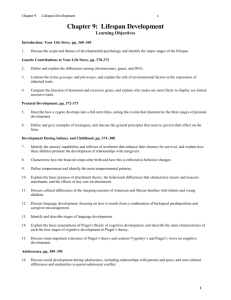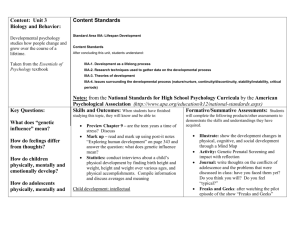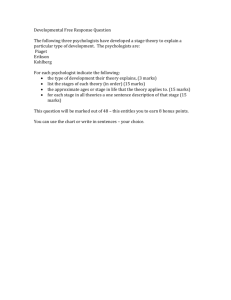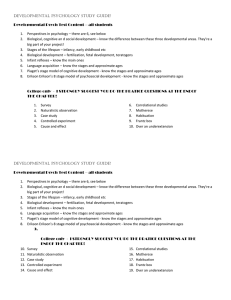Modules 13 - 16 Text Only Notes
advertisement
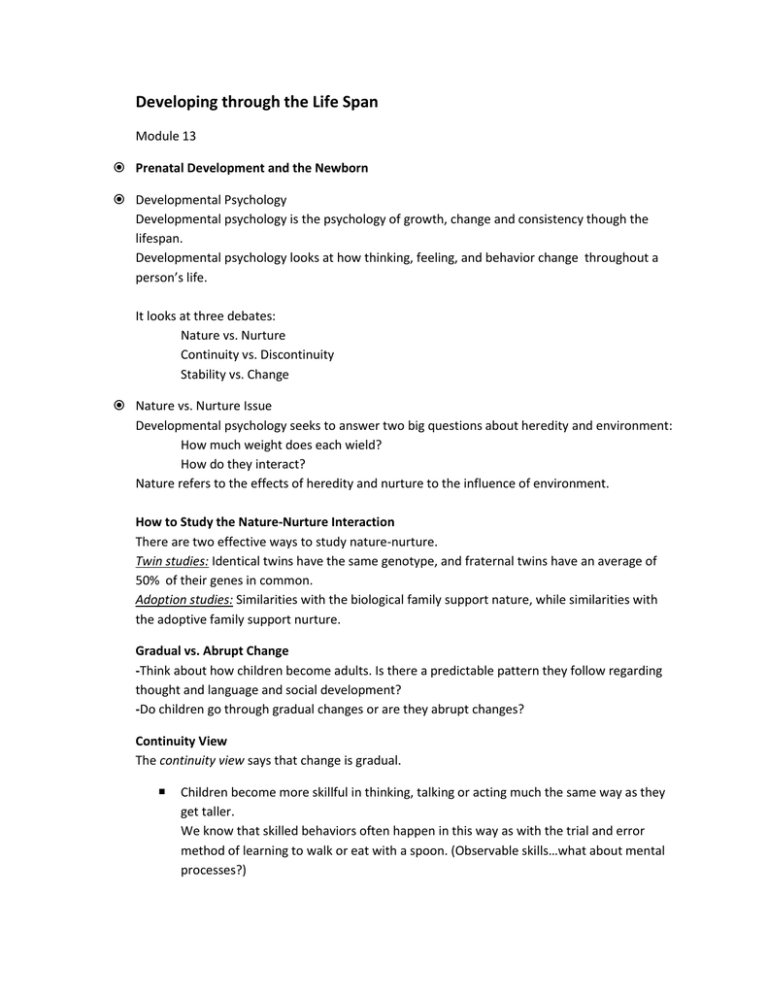
Developing through the Life Span Module 13 Prenatal Development and the Newborn Developmental Psychology Developmental psychology is the psychology of growth, change and consistency though the lifespan. Developmental psychology looks at how thinking, feeling, and behavior change throughout a person’s life. It looks at three debates: Nature vs. Nurture Continuity vs. Discontinuity Stability vs. Change Nature vs. Nurture Issue Developmental psychology seeks to answer two big questions about heredity and environment: How much weight does each wield? How do they interact? Nature refers to the effects of heredity and nurture to the influence of environment. How to Study the Nature-Nurture Interaction There are two effective ways to study nature-nurture. Twin studies: Identical twins have the same genotype, and fraternal twins have an average of 50% of their genes in common. Adoption studies: Similarities with the biological family support nature, while similarities with the adoptive family support nurture. Gradual vs. Abrupt Change -Think about how children become adults. Is there a predictable pattern they follow regarding thought and language and social development? -Do children go through gradual changes or are they abrupt changes? Continuity View The continuity view says that change is gradual. Children become more skillful in thinking, talking or acting much the same way as they get taller. We know that skilled behaviors often happen in this way as with the trial and error method of learning to walk or eat with a spoon. (Observable skills…what about mental processes?) Discontinuity View The discontinuity view sees development as more abrupt-a succession of changes that produce different behaviors in different age-specific life periods called stages. This is evident in beginning readers who suddenly discover the connection between letters and sounds. We often hear people taking about children going through “stages” in life (i.e. “terrible twos.”) These are called developmental stages-periods of life initiated by distinct transitions in physical or psychological functioning. Psychologists of the discontinuity view believe that people go through the same stages, in the same order, but not necessarily at the same rate. However, if a person misses a stage, it can have lasting consequences. Capabilities of Newborns People used to think that newborns began life as a “blank slate”-an empty brain and no abilities. Tabula rasa Studies have shown that newborns have innate abilities to find nourishment, interact with others and avoid harmful situations. Developmental Periods to Know Prenatal Period: The developmental period before birth. Neonatal Period: Birth-1 month. Infancy: 1 month-18/24 months. 1. Prenatal Period: 9 month developmental period before birth. During this time, the genetic plan determines how all of the organs that will be formed later begin to form. Here we get differentiation (cells forming specific organs). Before we differentiation, cells are “stem cells” and are capable of forming into any organ in the body. One concern during this time are teratogens, or substances from the environment that can damage the developing baby. A Tough Discussion Thirteen states can terminate parental rights if evidence of substance abuse exists during pregnancy. Eight states require doctors to report if evidence of parental substance abuse exists. -How do you think the criminal justice system should deal with mothers who abuse drugs during pregnancy? -If states pursue offenders of this crime, how do you think society, in general would be affected? Prenatal Stages of Development • Zygote -The fertilized egg -Enters a 2 week period of rapid cell division -Develops into an embryo • Embryo -The developing human organism from 2 weeks through 2nd month • Fetus -The developing human organism from 9 weeks after conception to birth -Prenatal Development and the Newborn Teratogens agents, such as chemicals and viruses, that can reach the embryo or fetus during prenatal development and cause harm Fetal Alcohol Syndrome (FAS) -physical and cognitive abnormalities in children caused by a pregnant woman’s heavy drinking symptoms include misproportioned head 2. Neonatal Period: Birth to one month old. -During this stage babies are capable of responding to stimulation from all of their senses. 3. Infancy Period: 1 mo. to 24 mo. This is a period of rapid development, but is still heavily reliant on reflexive behavior. Part of the reason we remember very little between birth and age 3 ½ is that our brain circuits are not fully developed Learning in Development During infancy, youngsters begin to exploit their abilities for learning. Crying, cooing, smiling, etc. Classical conditioning in newborns. Stroking forehead and giving sweets: Newborns who were stroked on the forehead were classically conditioned to turn their head toward the side where the sweetened water was provided, even if the bottle of water wasn’t present. Social Abilities During infancy we also see babies engage in a lot of social interaction. Synchronicity: close coordination between the gazing, vocalizing, touching and smiling of mothers and infants. Babies are preprogrammed to their mother’s voice Babies are preprogrammed to recognize faces This is so strong that we will see infants engage in the same behavior as their mother. Laugh when she laughs/cry when she displays negative emotion. Prenatal Development and the Newborn -Rooting Reflex tendency to open mouth, and search for nipple when touched on the cheek Preferences - human voices and faces -smell and sound of mother Mimicking The idea that babies will mimic is not something that is unique to human babies. Module 14 Infancy and Childhood Maturation Maturation is the orderly sequence of biological growth by which an organism develops over time, both physically and mentally. -Studies have shown that, when raised under adequate environment, maturation follows a predictable pattern. -Maturation sets the basic course of development, experience adjusts it. Cognitive Development: Piaget’s Theory -Jean Piaget developed a theory about development called the Cognitive Theory of Development. -Piaget’s theory was a discontinuous stage model of development which said children will undergo a revolutionary change in thought at each stage. Piaget’s theory was based on three key ideas: Schemas Assimilation and accommodation Stages of cognitive development Schemas are mental structures that guide thinking. According to Piaget, they are also the building blocks of development. Schemas form and change as we develop and organize our knowledge to deal with new experiences and predict future events. Assimilation: process that modifies new information to fit with existing schemas or with what is already known. Babies suck on anything put in front of them as if it was a bottle. Accommodation: process of restructuring or modifying schemas to incorporate new information. When a child learns that a butterfly is not a “bird.” Assimilation makes new information fit our existing view of the world. Accommodation changes our views to fit new information. Piaget’s Stages: Sensorimotor Stage Sensorimotor Stage (Birth to age 2): children mostly give reflexive responses with very little thinking involved. Stranger Anxiety, or fear of strangers, is very common during this period (8 months). A major step in thinking happens by year two, the ability to make mental images of objects, called mental representation. This is the foundation of being able to problem solve Another key feature of this stage is object permanence, or the knowledge that objects exist independently of one’s own actions or awareness. Piaget’s Stages: Preoperational Stage Preoperational Stage (2 to 6/7 yeas of age): A stage marked by well-developed mental representation and the use of language. Despite these increased abilities, however, children still cannot solve problems requiring logical thought, but they can recognize when something is not right. Piaget developed other key features of the preoperational stage, including: Egocentrism: a self centered focus that causes children to see the world only in their own terms. Animistic thinking: believing inanimate objects have life and mental processes. Talking to child on phone “Bad table” Centration: an inability to understand an event because the child focuses their attention too narrowly. Moving objects closer together—now more or fewer items? Irreversibility: an inability to think through a series of events or steps and then reverse course. Artificialism: believing all objects are made by people. Piaget’s Stages: Concrete Operational Stage Concrete Operational Stage (7 to 11 years): child develops the abilities of irreversibility, conservation and mental operations. Conservation: the principle that quantity remains the same despite changes in shape. Mental operations: the ability to solve problems by manipulating images in one’s own mind. Piaget’s Stages: Formal Operational In Piaget’s final stage, formal operational stage, he says people begin to think about issues like being more accepted by peers, and abstract issues like love, fairness and our reason for existence. Consists of 4 unique structural properties: Hypothetical reasoning Analogical/Abstract reasoning Deductive reasoning Reflective abilities Piaget’s Stages of Cognitive Development Infancy and Childhood: Cognitive Development Object Permanence the awareness that things continue to exist even when not perceived Baby Mathematics Shown a numerically impossible outcome, infants stare longer (Wynn, 1992) Conservation the principle that properties such as mass, volume, and number remain the same despite changes in the forms of objects Egocentrism the inability of the preoperational child to take another’s point of view Theory of Mind people’s ideas about their own and others’ mental states - about their feelings, perceptions, and thoughts and the behavior these might predict Autism a disorder that appears in childhood Marked by deficient communication, social interaction and understanding of others’ states of mind Theory of mind is the ability to infer (understand) other’s mental states, and know they may be different than our own. Piaget thought this did not happen until around age 8, but studies suggest this actually happens as young as age 4 or 5. Social Development Stranger Anxiety fear of strangers that infants commonly display beginning by about 8 months of age Attachment an emotional tie with another person shown in young children by their seeking closeness to the caregiver and displaying distress on separation Critical Period an optimal period shortly after birth when an organism’s exposure to certain stimuli or experiences produces proper development Imprinting the process by which certain animals form attachments during a critical period very early in life Example: A baby chick is hatched by a mother duck. The chick will follow the duck around and even try to get into the pond with the mother duck and her ducklings. Imprinting with Human Babies While human babies are not as capable to move around at an early age, they will develop a strong connection to anyone who responds regularly to their signals-crying, cooing, smiling...etc. Harlow’s Surrogate Mother Experiments -Monkeys preferred contact with the comfortable cloth mother, even while feeding from the nourishing wire mother Just how Strong is Imprinting? One study found that when mothers left the room, 2-4 month old babies’ skin temperature dropped, a sign of emotional distress. In these youngsters, skin temperature dropped even more when the mother was replaced by a stranger. -In contrast, skin temperature remained constant steady if the mother stayed in the room-even if the stranger was present. -Monkeys raised by artificial mothers were terror-stricken when placed in strange situations without their surrogate mothers. -Lasting Effects Despite the strength of attachment and imprinting, individuals who lack healthy attachments in infancy are not necessarily doomed for life. -While attachment problems are good predictors of later problems with social relationships, many people do succeed in overcoming early attachment issues. -During early development we also see attachment, or the enduring social-emotional relationship between a child and parent or caregiver. -Attachment occurs instinctively in many species. One example in birds is called imprinting where a powerful attraction occurs between infants and the first moving object or individual they spend time with. Module 15 Adolescence the transition period from childhood to adulthood extending from puberty to independence Puberty the period of sexual maturation when a person becomes capable of reproduction Primary Sex Characteristics body structures that make sexual reproduction possible ovaries--female testes--male external genitalia Secondary Sex Characteristics nonreproductive sexual characteristics female--breast and hips male--voice quality and body hair Menarche (meh-NAR-key) first menstrual period In the 1890’s the average interval between a woman’s menarche and marriage was about 7 years; now it is over 12 years Adolescence Throughout childhood, boys and girls are similar in height. At puberty, girls surge ahead briefly, but then boys overtake them at about age 14. Body Changes at Puberty Lev Vygotsky Piaget’s emphasis on how the child’s mind grows through interaction with the physicl environment is complemented by Vygotsky’s emphasis on how the child’s mind grows through interaction with the social environment. Language is an important ingredient in social mentoring that provides the building blocks for thinking. Zone of Proximal Development Vygotsky stated that a child follows an adult's example and gradually develops the ability to do certain tasks without help or assistance. Zone of proximal development presents it as “the distance between the actual developmental level as determined by independent problem solving and the level of potential development as determined through problem solving under adult guidance, or in collaboration with more capable peers” Erikson’s Theory of Psychosocial Development -Erik Erikson saw human development as a sequence of psychosocial stages, defined by common problems that emerge throughout life. -Erikson identified 8 stages, with each bringing a new challenge. To move onto the next stage of life, the problem of the previous stage must successfully be coped with. -Like Freud and many others, Erik Erikson maintained that personality develops in a predetermined order. Instead of focusing on sexual development, however, he was interested in how children socialize and how this affects their sense of self. -He saw personality as developing throughout the lifetime and looked at identity crises at the focal point for each stage of human development. Erikson Summarized -His model was a lifespan model of development, taking in 5 stages up to the age of 18 years and three in adulthood. -There is still plenty of room for continued growth and development throughout one’s life. -According to the theory, successful completion of each stage results in a healthy personality and successful interactions with others. -Failure to complete a stage can result in a reduced ability to complete further stages and resulting in an unhealthy personality and sense of self. -Stages can be resolved successfully at a later time. Criticisms of Erikson Critics of Erikson said his “research” was based on clinical observations and lacked rigorous scientific method. -Also, critics said it did not do enough to adequately capture the problems faced by girls and women. Can you think of “problems” females face that do not have a place in Erikson’s stages? Erikson’s Theory of Young Adulthood -The big challenge Erikson singles out for young adults is establishing close relationships with other adults. -The individual must resolve the conflict between wanting to establish closeness to another and fearing the vulnerability and risks such closeness can bring. -Making intimate commitments requires compromising personal preferences, accepting responsibilities and yielding some privacy and independence. Erikson’s Deep Thought Anything that isolates us from sources of social support-from a reliable network of friends and family-puts us at risk for a host of physical ills, mental problems, and even social pathologies. -We are social creatures and we need each others help to and support to be effective and healthy. Erikson on Relationships -We are social creatures and we need each others help to and support to be effective and healthy. -Erikson said you must know who you are before you can begin to love someone else and share your life with that person. Basic Trust (Erik Erikson)a sense that the world is predictable and trustworthy said to be formed during infancy by appropriate experiences with responsive caregivers Self-Concept a sense of one’s identity and personal worth Social and Emotion Development Part of the health and happiness of humans derives from having healthy, happy, intimate relationships with people. -To go beyond the egocentric problem of young children, we must develop a theory of mind Awareness that others may have beliefs, thoughts, desires and emotions different from one’s own. -Why would theory of mind be important to development and socialization? Identity -one’s sense of self -the adolescent’s task is to solidify a sense of self by testing and integrating various roles Intimacy -the ability to form close, loving relationships -a primary developmental task in late adolescence and early adulthood Kohlberg’s Moral Ladder As moral development progresses, the focus of concern moves from the self to the wider social world. Parenting Most styles of parenting fall into one of four distinct styles that psychologists have found all around the world. Authoritative Authoritarian Permissive Uninvolved Authoritarian -parents impose rules and expect obedience - “Don’t interrupt.” “Why? Because I said so.” Permissive submit to children’s desires, make few demands, use little punishment Authoritative both demanding and responsive set rules, but explain reasons and encourage open discussion Results of Parenting Does the type of parent you are matter? Research suggests that children or parents who were authoritative tend to be confident, self-reliant, enthusiastic and overall happier. Children with authoritarian parents tend to be anxious and insecure while those with permissive parents tend to be immature, impulsive, dependant and demanding. Daycare: Bad or Good? -Day cares are growing in size and number in our country. There has also been a growing feeling that daycares might have adverse effects on children. -Research has shown that most children thrive in day care, especially socially. However, a poor- quality daycare experience can influence children to be aggressive, depressed or otherwise maladjusted. Leisure Time & Effects of Chores -While long hard work may teach discipline, responsibility and appreciation, there is little evidence that it produces positive changes in cognitive development. -American children also spend less time doing school work than children in other developed countries (though more than American children did in the past). Leisure Time -A good portion of American children’s time is spent watching TV, talking on the phone, surfing the internet, or “hanging out.” -Many children spend the majority of their free time in structured activities like clubs or sports teams. Gender Differences -It is clear that gender differences exist in children. The sexes tend to segregate themselves, which is a pattern that holds true across cultures. -Girls tend to organize themselves in small, cooperative groups. Boys often form larger groups that have a hierarchical structure. Explanations for Differences -Evolutionary psychologists believe these gender differences have an innate basis, which may be related, in part to gender differences in testosterone levels. -Social-cognitive psychologists believe children also learn gender roles and gender related behaviors such as aggressiveness, competitiveness or cooperation. Differences Between Then and Now -While most psychologists support Erikson’s thoughts on adult development, they realize that young adults today face different situations than they have in the past. -Today, many young adults live together before they are married. While this may be better in the long run, individuals may struggle with identity issues at the same time they are trying to deal with intimacy issues. Module 15 Adulthood and Reflections on Developmental Issues Psychology Beyond Adulthood -Until the last few years, there was little psychological research done on young adults, and almost none on people past their mid 20s. -Within the next 10 years, a big part of our population will be made up of baby boomers who are living longer and encountering more issues physically and psychologically than any group before them. Menopause -the time of natural cessation of menstruation also refers to the biological changes a woman experiences as her ability to reproduce declines Alzheimer’s Disease a progressive and irreversible brain disorder characterized by a gradual deterioration of memory, reasoning, language, and finally, physical functioning Adulthood: Physical Development - Slowing reactions contribute to increased accident risks among those 75 and older. Adulthood: Cognitive Development -Recalling new names introduced once, twice, or three times is easier for younger adults than for older ones (Crook & West, 1990). -In a study by Schonfield & Robertson (1966), the ability to recall new information declined during earlyand middle adulthood, but the ability to recognize new information did not. Cross-Sectional Study -a study in which people of different ages are compared with one another Longitudinal Study -a study in which the same people are restudied and retested over a long period Adulthood- Cognitive Development -Verbal intelligence scores hold steady with age, while nonverbal intelligence scores decline (adapted from Kaufman & others, 1989) Crystallized Intelligence -one’s accumulated knowledge and verbal skills tends to increase with age Fluid Intelligence -one's ability to reason speedily and abstractly tends to decrease during late adulthood Social Clock -the culturally preferred timing of social events such as: marriage parenthood retirement Multinational surveys show that age differences in life satisfaction are trivial (Inglehart, 1990). Challenges of Midlife -Erikson singled out generitivity, as the big challenge facing middle aged adults. -Generitivity is the process of making a commitment beyond oneself to family, work, society or future generations. -This is a crucial challenge of adults in their 30s, 40s and 50s. -The good news is that most people do not actually undergo a true midlife crisis or upheaval. Erikson’s Last Stage -The last stage of Erikson’s model deals with elderly people. -The big challenge in this stage is ego-integrity vs. despair. Erikson describes this as the challenge to have a life we can look back on and have no regrets about and to enjoy a sense of wholeness. In the End Death is inevitable. It is something we will all go through. But, do we go through it the same way? According to Elisabeth Kubler-Ross, we do, in five stages. While we each experience the stages differently, we will all go through the following: Denial Anger Bargaining Depression Acceptance The Stages Denial- Refusing to believe the individual is sick. Anger- Displays anger that individual is sick. Bargaining- Making a deal, in return for a cure, they will fulfill a promise. Depression- General depression affecting sleeping and eating patterns. Acceptance-The realization that death is inevitable.




